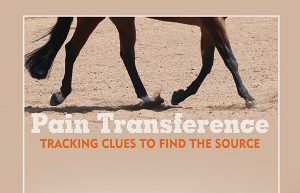Pain Transference – Tracking Clues to Find the Source
Click here to read the complete article
While lameness can only be definitively diagnosed by a veterinarian, your detective work can help to mitigate issues and speed recovery. Lameness is an indicator that something within a horse’s body hurts. In turn, the horse will alter his gait to control the amount of load the affected limb has to bear. Pain is the most common cause of lameness in all horses, though mechanical restrictions or neuromuscular disease can be factors.
Extreme cases are easy to spot, but lameness might only cause a subtle change in gait, a grumpy attitude, or a decrease in athletic ability. Consider that lameness might be the root cause of a horse’s poor performance rather than a riding or training issue.
Even for highly skilled equine veterinarians, lameness diagnosis and treatment is both art and science. The American Association of Equine Practitioners (AAEP) stresses that it’s important to know that the site or nature of the injury cannot always be determined by the appearance of the lameness or the way a horse moves. Pain from skin wounds, connective tissue bruising, muscle pain, laminitis, arthritis, inflammation, tendon and ligament injury, and bone injury can result in lameness that cannot be differentiated by observing a horse’s gait. To make the detective work even harder, horses may develop compensatory gait abnormalities to deal with the primary problem. Lameness in one part of a limb often results in secondary soreness in another area. It may appear that lameness is in the right forelimb, but the true cause may be in the left hind. Therefore, the AAEP advises that the entire horse should be evaluated for secondary lameness, even when the cause of the primary problem is obvious.
Basic Evaluation
One consistent clue to lameness is that the horse reduces the amount of time or amount of force applied to the weight-bearing limb that’s in pain. Start by observing the horse from all angles when standing. You want to look for any pronounced asymmetry in muscle mass, limb conformation, or joint size. Next, you want to observe the horse while moving. View the horse trotting toward, away, and past you. Vets generally look for lameness at the trot, because it’s a symmetrical, simple, two-beat gait. Horses may not exhibit a problem at the walk, because there is minimal concussion. The canter is too fast and asymmetrical for most eyes to distinguish a subtle gait problem. Advanced analysis techniques with sensors evaluate the horse at all gaits and can even measure impact and push-off pressure; but, for your initial investigation, all you need are your eyes, ears, and a good trotting surface.
Click here to read the complete article











